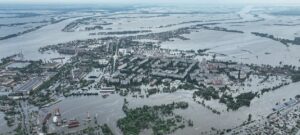Destruction of the Kachowka Dam and its Consequences
 Kachowka Dam Breach Results in Environmental Damage
Kachowka Dam Breach Results in Environmental Damage
The Kachowka Dam in Ukraine, which held 18 billion cubic meters of water, was deliberately destroyed, causing fuel and lubricants to contaminate the rivers. Around one and a half months after the dam’s destruction, the water of the Dnipro River has flowed downstream to Cherson and its surroundings, approximately 80 kilometers away. While the ecological assessment is still ongoing, initial reports suggest that the fears of a mass fish die-off have not been confirmed in Wolodymyr Polchovksyi’s area. Although the water levels in some of the Dnipro’s tributaries have slightly decreased, it has not yet reached a critical level for the fish population.
The Work of a Fish Inspector in Cherson
Fish Inspector Ensures Aquatic Resources in Cherson
Wolodymyr Polchovksyi, a fish inspector in his early thirties, works in the Cherson region, monitoring the stock of fish species such as pike, carp, bream, and crayfish in the water-rich area near the Black Sea. Due to the contamination and untreated water entering the rivers and lakes, fishing and the sale of fish remain prohibited by the regional military administration. Polchovksyi and his team are actively seeking out illegal anglers and poachers to protect the aquatic resources.
Devastation caused by the Flood and Concerns for the Ecological Balance
Devastation and Ecological Concerns in the Cherson Region
Standing on the banks of the Koschewa River in Cherson, Fish Inspector Polchovskyi describes his work, interrupted by the sound of artillery fire. The constant Russian shelling in the region has not ceased. Despite the noise, Polchovskyi continues unaffected, stating that it is always loud in their area, with both Ukrainian and Russian artillery audible.
After the destruction of the Kachowka Dam in early June, the powerful Dnipro River flooded the area uncontrollably. Polchovskyi points across the river towards the town of Beloserka, explaining that it was heavily flooded. He mentions that a nearby landfill was completely submerged, along with the sewage treatment plants that normally clean the water from drainage pits. As the water gradually receded, everything flowed into the Dnipro River, with the garbage now unseen but already in the river.
Devastated Fields and Losses for Farmers
Farmers Face Devastation and Million-Dollar Losses
Wadim Scheremet, a farmer from Pavlo-Maryniwka in the Mykolajiw region, surveys his devastated fields grimly. The consequences of the catastrophic flooding add to the many problems he already faces, including landmines, plummeting grain prices, and export issues. Scheremet laments the loss of income from this year’s harvest and the need to wait for the next one. He states that farmers in Ukraine are losing millions of dollars.
Pavlo-Maryniwka, located along the Inhulets River, experienced severe flooding in early June, affecting fertile fields of crops, vegetables, and strawberries. The flooding also impacted plants and animals in decades-old nature reserves in the region, according to Fish Inspector Polchovskyi.
The Ongoing War and Environmental Impact
Environmental Impact of the War in Cherson
The war continues in Cherson, where the Dnipro River now serves as the front line. Since its recapture in November, the city has been shelled by Russian forces over 4,000 times. According to the regional military administration, more than 370 people have been injured, and at least 135 have lost their lives due to shelling while waiting at bus stops, shopping in markets, or evacuating from the life-threatening floods.
When Cherson was liberated and Russian troops withdrew, areas such as the seaport, river port, and parts of the shipyard, where the fleet and large steamships were located, were blown up and flooded, as stated by the fish inspector. Fuel and lubricants flowed into the river, and the extent of the ecological damage is still difficult to assess. However, Polchovskyi firmly believes that “it affects not only Ukraine and the Cherson region but will reach the coasts of Europe.”
Polchovskyi gazes along the banks of the Koschewa River, aware that there was Russian shelling on the opposite side that morning. Like everyone else in the area, he lives in danger but continues his work as before.




























































